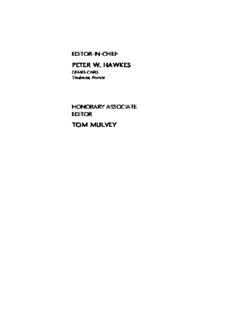Table Of ContentEDITOR-IN-CHIEF
PETER W. HAWKES
CEMES-CNRS
Toulouse,France
HONORARY ASSOCIATE
EDITOR
TOM MULVEY
AcademicPressisanimprintofElsevier
Radarweg29,POBox211,1000AEAmsterdam,TheNetherlands
32JamestownRoad,LondonNW17BY,UK
30CorporateDrive,Suite400,Burlington,MA01803,USA
525BStreet,Suite1900,SanDiego,CA92101-4495,USA
Firstedition2009
Copyright#2009ElsevierInc. Allrightsreserved.
Nopartofthispublicationmaybereproduced,storedinaretrievalsystem
ortransmittedinanyformorbyanymeanselectronic,mechanical,photocopying,
recordingorotherwisewithoutthepriorwrittenpermissionofthepublisher.
PermissionsmaybesoughtdirectlyfromElsevier’sScience&Technology
RightsDepartmentinOxford,UK:phone(+44)(0)1865843830;fax(+44)(0)1865
853333;email:[email protected]
yourrequestonlinebyvisitingtheElsevierwebsiteathttp://elsevier.com/locate/
permissions,andselectingObtainingpermissiontouseElseviermaterial.
Notice
Noresponsibilityisassumedbythepublisherforanyinjuryand/ordamage
topersonsorpropertyasamatterofproductsliability,negligenceorotherwise,or
fromanyuseoroperationofanymethods,products,instructionsorideas
contained in the material herein. Because of rapid advances in the medical
sciences,inparticular,independentverificationofdiagnosesanddrug
dosagesshouldbemade.
LibraryofCongressCataloging-in-PublicationData
AcatalogrecordforthisbookisavailablefromtheLibraryofCongress
BritishLibraryCataloguinginPublicationData
AcataloguerecordforthisbookisavailablefromtheBritishLibrary
ISBN:978-0-12-374768-6
ISSN:1076-5670
ForinformationonallAcademicPresspublications
visitourWebsiteatwww.books.elsevier.com
PrintedintheUnitedStatesofAmerica
09 10 10 9 8 7 6 5 4 3 2 1
Dedication
Dedicated to the memory of my mother, Stella Yakovlevna Yavor, who
wasalsomyfirstteacherofchargedparticleoptics.
v
Preface
ItisapleasuretowelcomeMikhailYavorbacktotheseAdvances.In1993,
hecontributedalongchapteronparasiticaberrationsinelectronoptics,in
1998heexaminedtheopticsofsystemswithnarrowgapsandnowhehas
written anentire volume on energy and mass analyzers. Although there
have been long accounts of some of these instruments, this is the only
recent text that covers energy analyzers, mass analyzers, time-of-flight
devicesandradiofrequencyanalyzers.Thishastheadditionaladvantage
that the vocabulary and notation are uniform throughout for all these
differentmembersoftheanalyzerfamily.Thechoiceoftopicscoveredis
described in the author’s Foreword and hence not repeated here. I will,
however, insist that this account is intended to be readable by a wide
audience, and in particular by users of these instruments. It is by no
meanslimitedtodesignersofanalyzersandthoseinterestedintheiroptics.
I am sure that this long and meticulous account of the optics and
behaviorofallthesedifferentkindsofenergyandmassanalyzerwillbe
heavily used and am delighted to include it in these Advances. The
dedicationisapleasantreminderthattheycancreatefamilyallegiances,
forthelateStellaYavorwasalsoacontributor,aslongagoas1989,writing
onelectrostaticlenseswithL.A.Baranova.
When this volume was about to go to press, I learned of the recent
deathofone ofour HonoraryAssociateEditors,Ben Kazan.Atribute to
him will be included in the Preface to the next volume and meanwhile,
Iextendallsympathytohisfamilyonbehalfofthepublishersandmyself.
PeterW.Hawkes
xiii
Foreword
Two main reasons encouraged me to write on optics of charged particle
analyzers.Thefirstistheobviouslackofgeneralliteratureonthesubject.
Despite ever-growing competition in performance of modern analytical
devicesusingelectronandionspectrometricmethodsofinvestigationof
thestructureofvarioussubstances,theprinciplesandspecificfeaturesof
chargedparticle optical designsof these deviceshave not been gathered
ingeneral-purposebooksfordecades.Theexceptionsarequadrupoleand
ion trap spectrometers, which are well covered by recent publications,
alsoconsideringamongothersion-opticalaspects(Ghosh,1995;Dawson,
1997; March and Todd, 2005). Wollnik’s book (1987a) is the only book
devotedtotheopticsofothertypesofchargedparticleanalyzers,butitis
already more than twenty years old and covers only sector field instru-
mentsandmultipoles.Surveysonchargedparticleopticsoftime-of-flight
(TOF)massspectrometersorelectrostaticenergyanalyzerscanbefound
onlyinrelativelyshort(andolder)articles.
Contemporary charged particle spectrometers are, as a rule, compli-
cated devices that often include very different types of optical elements.
Forexample,aTOFspectrometermayconsistofagas-filled quadrupole
for cooling ions,a static focusingchannel,a pulsed ionconverter (some-
times followed by an energy filter), and finally, a mirror- or sector-type
TOF mass analyzer itself. Tandem mass spectrometers are even more
complexandcancombinestaticanddynamicmassanalyzers.Designers
of such instruments must have a good knowledge of all these elements.
However,norecentliteraturepresentschargedparticleopticalaspectsof
differenttypesofelectronandionanalyzersandtheirrelatedtransporting
interfaces.Thismonographisintendedtofillthisgap.
The second reason is a desire to address this monograph to a larger
community.Itisnotasecretthatmostexcellentbookswrittenbyexperts
in charged particle optics have been intended, with few exceptions, for
expertsinchargedparticleoptics.Myexperienceofcommunicationwith
peopleinvolvedinthedesignofanalyticalinstrumentshasrevealedthat
manyofthem,thoughnotdesignersofparticularlychargedparticleoptic
schemes, still would like to understand the principles of optical design.
They are notparticularly interested in complicated expressionsfor aber-
rationcoefficientsorothermathematicaldetails,buttheywanttoseehow
xv
xvi Foreword
anopticalelementworks,whyitisdesignedinthisandnotinsomeother
way, and what is essential in the optical design. In talking with such
people, as well as with many students, I often experienced problems in
recommending suitable reading. Finally, I decided to write this mono-
graph. My intention was to review the current state of charged particle
optical knowledge in the field of electron and ion analyzers and, at the
same time, to make the material relatively easy to read. Although it was
impossibletoavoidmathematicalformulas,Itriedwheneverpossibleto
emphasize the physical principles and qualitative descriptions. Readers
willjudgewhetherthisgoalhasbeenachieved.
Becauseinanydiscussionofchargedparticlespectrometersitisdiffi-
cult to separate functionally pure analyzing optic elements from the
elements of particle transporting channels, this monograph presents
both.What is left asideis theoptics of electronand ion sources,because
surveyingthissubjectrequiresaprofoundknowledgeofsolidstatephys-
icsandothersimilartopicsinwhichIdonotconsidermyselfanadequate
expert.Themonographcontainstwointroductorysections.Thefirstcon-
tains basic reminders of the properties of quasi-static electric and mag-
neticfields,aswellasthegenerallawsofchargedparticlemotioninsuch
fields.Thesecondsectiondescribesthelanguageofaberrationexpansions
used for analysis of charged particle optical properties of all types of
analyzers except radiofrequency (RF) analyzers and Penning traps.
Sections 3 and 4 are devoted to optics of elements of charged particle
transporting channels, both static and RF. Because it is not possible to
describeallthenumeroustypesofelectronandionlenses,Iattemptedto
survey those most often used in charged particle spectrometers or those
that seem promising but undeservedly forgotten (e.g., crossed lenses).
Later sections consider the analyzers themselves: magnetostatic, electro-
static,combined,TOF,andfinally,RFones.Thelastclassofmassanaly-
zersissurveyedmorebrieflysoastonotsimplycopysimilarinformation
availablefromotherrecentbooks.Inallcaseswheredetailsofdesignsor
effectswereomitted,Ihavetriedtosupplyreferencestotheliteraturein
whichthesedetailscanbefound.
Unfortunately,onemonographdoesnotallowthespacetoaccommo-
datedescriptionsofallkindsofmassanalyzersandalltheirfeatures.My
choice of the mass analyzers presented herein was based on either their
popularity or the promises they offer, although my own personal taste
also contributed a little. As far as the analyzer properties are concerned,
the lack ofspacehasforced theomission in most cases thediscussion of
spacechargeeffects,manufacturingtolerances,andrequirementsrelated
tothestabilityofpowersupplies.
Writing this monograph was possible because of my many years of
interaction with leading experts in the field. First, I would like to thank
two persons: Prof. Dr. H. Wollnik and Dr. A. N. Verentchikov. Working
Foreword xvii
withthematdifferentperiodsallowedmetoreachalevelatwhichIcould
startwritingthismonograph.MyspecialthanksgoestoDr.A.Berdnikov,
whoseexperienceinmathematicsingeneralandinnumericalmethodsof
computing charge particle optics systems in particular rendered me a
great service. I am very grateful to the scientific leader of the Flerov
Laboratory of Nuclear Reactions in JINR (Dubna), academician Yu.Ts.
Oganessian, the laboratory and group leaders at GSI (Darmstadt), Prof.
Dr. C. Scheidenberger and Prof. Dr. H. Geissel, the group leader at the
Second Physical Institute of the Justus-Liebig University in Giessen,
Dr. W. R. Plass, and the members of their teams: Dr. A. G. Popeko, Dr.
H.Weick,Dr.M.Winklerandothersforfruitfulcollaboration.Mysincere
thankstomycolleaguesintheInstituteforAnalyticalInstrumentationin
St.Petersburg:Prof.L.N.Gall,Prof.Yu.K.Golikov,Dr.Yu.I.Hasin,Dr.
V.D.Belov,Dr.N.V.Krasnov,Dr.A.P.Shcherbakov,M.Z.Muradymov,
and many others for communications affording me invaluable experi-
ence.Finally,Iamgratefultotheexpertsinchargedparticleopticdesign
with whom my destiny intersected and from whom I gained a profes-
sionalexperience:Dr.A.J.H.Boerboom,Dr.D.Ioanoviciu,andDr.E.de
Chambost.
Manyoftheillustrationsinthebookwerecreated withtheaidofthe
computer programs SIMION 8.0 (Manura and Dahl, 2006) and GICOSY
(Wollnik,Hartmann,andBerz,1988).
Future Contributions
S.Ando
Gradientoperatorsandedgeandcornerdetection
K.Asakura
Energy-filteringx-rayPEEM
W.Bacsa
Opticalinterferencenearsurfaces,sub-wavelengthmicroscopy
andspectroscopicsensors
C.Beeli
Structureandmicroscopyofquasicrystals
C.BobischandR.Mo¨ller
Ballisticelectronmicroscopy
G.Borgefors
Distancetransforms
Z.Bouchal
Non-diffractingopticalbeams
A.Buchau
Boundaryelementorintegralequationmethodsforstaticandtime-dependent
problems
B.Buchberger
Gro¨bnerbases
E.Cosgriff,P.D.Nellist,L.J.Allen,A.J.d’Alfonso,S.D.FindlayandA.I.Kirkland
Three-dimensionalimagingusingaberration-correctedscanningconfocal
electronmicroscopy
T.Cremer
Neutronmicroscopy
A.V.Crewe(specialvolumeonSTEM,159)
EarlySTEM
xix
xx FutureContributions
P.Dombi(vol.158)
Ultra-fastmonoenergeticelectronsources
A.Engel(specialvolumeonSTEM,159)
STEMinthelifesciences
A.N.Evans
Areamorphologyscale-spacesforcolourimages
A.X.Falca˜o
Theimageforestingtransform
R.G.Forbes
Liquidmetalionsources
B.J.Ford(vol.158)
Theearliestmicroscopicalresearch
C.Fredembach
Eigenregionsforimageclassification
J.Giesen,Z.Baranczuk,K.SimonandP.Zolliker
Gamutmapping
J.Gilles(vol.158)
Noisyimagedecomposition
A.Go¨lzha¨user
Recentadvancesinelectronholographywithpointsources
M.Haschke
Micro-XRFexcitationinthescanningelectronmicroscope
P.W.Hawkes(specialvolumeonSTEM,159)
TheSiemensandAEISTEMs
L.Hermi,M.A.KhabouandM.B.H.Rhouma
ShaperecognitionbasedoneigenvaluesoftheLaplacian
M.I.Herrera
ThedevelopmentofelectronmicroscopyinSpain
H.Inada(specialvolumeonSTEM,159)
Developmentofcoldfield-emissionSTEMatHitachi
M.S.Isaacson(specialvolumeonSTEM,159)
EarlySTEMdevelopment
J.Isenberg
ImagingIR-techniquesforthecharacterizationofsolarcells
FutureContributions xxi
K.Ishizuka
Contrasttransferandcrystalimages
A.Jacobo
IntracavitytypeIIsecond-harmonicgenerationforimageprocessing
B.Jouffrey(specialvolumeonSTEM,159)
TheToulousehigh-voltageSTEMproject
L.Kipp
Photonsieves
G.Ko¨gel
Positronmicroscopy
T.Kohashi
Spin-polarizedscanningelectronmicroscopy
O.L.Krivanek(specialvolumeonSTEM,159)
Aberration-correctedSTEM
R.Leitgeb
Fourierdomainandtimedomainopticalcoherencetomography
B.Lencova´
Moderndevelopmentsinelectronopticalcalculations
H.Lichte
Newdevelopmentsinelectronholography
M.Mankos
High-throughputLEEM
M.Matsuya
CalculationofaberrationcoefficientsusingLiealgebra
S.McVitie
Microscopyofmagneticspecimens
I.MorenoSorianoandC.Ferreira
FractionalFouriertransformsandgeometricaloptics
M.A.O’Keefe
Electronimagesimulation
D.OultonandH.Owens
Colorimetricimaging
N.PapamarkosandA.Kesidis
TheinverseHoughtransform
Description:Advances in Imaging and Electron Physics merges two long-running serials--Advances in Electronics and Electron Physics and Advances in Optical and Electron Microscopy. This series features extended articles on the physics of electron devices (especially semiconductor devices), particle optics at hig

